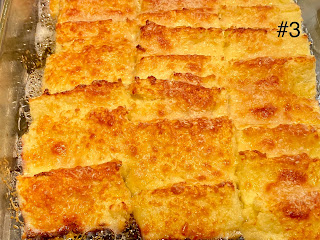The “rivel” layer is difficult to see but it is there as is the dried fruit.
Ingredients: My wife will tell what she did to make the cake (makes two round 8 inch cake/bread)
1/2 cup warm mashed sweet potato (please note the original recipe specifies HOT)
1 1/2 cup buttermilk
1/2 cup butter
1 egg
1/2 cup sugar
2 tsp. salt
1/2 tsp. nutmeg
1 pkg active dry yeast
1/4 cup warm water if blooming the yeast
4 cups of AP flour to start, adding more as needed to make velvety dough.
1 cup of dried fruit cut into small pieces
Ingredients and directions for rivels (Crumb topping)
Mix together 1/2 cup sugar, 1/2 cup flour and 4 tbs. butter softened until the ingredients are completely combined and look like fine crumbs. (I added the ingredients to a small food processor and processed it until small clumps formed. These rivals were much finer than the ones made by hand.)
Directions:
Put the mashed potatoes into the bowl of a stand mixer. Using a mixing paddle beat in the butter, then the egg and a mixture of sugar, salt and nutmeg. Beat until fluffy. Bloom the yeast in warm water.
Beat the yeast into the potato mixture. Switch to a dough hook and alternately add the flour and milk beating well after each addition. If necessary add more flour to make a soft dough. Knead the dough on a floured surface until smooth and satiny. Spread the dough into a flat square and cover the square with the dried fruit then fold the dough over the fruit and knead until the fruit is well distributed. Put the dough into a greased bowl. Grease the top of the dough, cover and let rise in a warm place until doubled.
Punch down the dough. Since the recipe makes two cakes split the dough into quarters so the rivals can be put into the middle of each cake. Then put 1/4 of the dough in the bottom of the 8 inch pan (#1). Sprinkle on 1/4 of the rivels (#2) and top that layer with another quarter of dough (#3). Do this for both cakes. Brush the tops with melted butter and cover both with the remaining rivels. Let the cakes rise in a warm place for about 30 to 40 minutes while the oven preheats. (This is a variation from the original PA Dutch recipe. It does not call for the second rise; the cakes are cooked immediately after they are put in the pan. I’ve made fastnacht cakes both ways and think the cake made with a second rise is much better. It comes out much thicker and has a lovely tender texture.) Cook in a 400 degree oven for about 20 minutes or until golden brown. Picture (#4) shows the cake as it came out of the oven.




.jpeg)
















 *Digression alert:
*Digression alert:



















